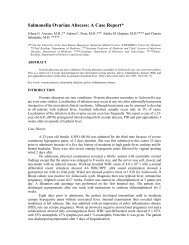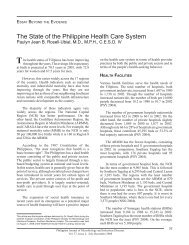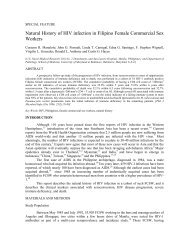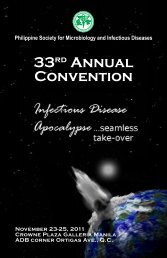The Philippine Clinical Practice Guideline on the Diagnosis and ...
The Philippine Clinical Practice Guideline on the Diagnosis and ...
The Philippine Clinical Practice Guideline on the Diagnosis and ...
You also want an ePaper? Increase the reach of your titles
YUMPU automatically turns print PDFs into web optimized ePapers that Google loves.
Asymptomatic bacteriuria in pregnancy is defined clinically by: (a) >100,000 cfu/ml with<br />
<strong>on</strong>e or more organisms in two c<strong>on</strong>secutive mid-stream urine specimens or <strong>on</strong>e ca<strong>the</strong>terized urine<br />
specimen, <strong>and</strong> (b) <strong>the</strong> absence of symptoms attributable to urinary infecti<strong>on</strong>.<br />
2. Screening for asymptomatic bacteriuria in pregnancy<br />
All pregnant women, particularly those at high risk of developing acute cystitis <strong>and</strong> acute<br />
pyel<strong>on</strong>ephritis, e.g. diabetics <strong>and</strong> those with a previous history of UTI, must be screened for<br />
asymptomatic bacteriuria <strong>on</strong> <strong>the</strong>ir first prenatal visit (Grade A).<br />
2.2 A st<strong>and</strong>ard urine culture using a clean catch midstream urine is <strong>the</strong> test of choice in screening<br />
for asymptomatic bacteriuria (Grade A). In areas where urine culture facilities are not available, a<br />
urine gram stain is an acceptable substitute (Grade C). Leukocyte esterase <strong>and</strong> nitrite tests are not<br />
recommended for screening for ASB (Grade E). Urinalysis al<strong>on</strong>e is not recommended for<br />
screening (Grade C).<br />
3. Treatment of asymptomatic bacteriuria in pregnancy<br />
3.1 Antibiotic treatment for asymptomatic bacteriuria is indicated to reduce <strong>the</strong> risk of acute<br />
cystitis <strong>and</strong> pyel<strong>on</strong>ephritis in pregnancy as well as reduce <strong>the</strong> risk of LBW ne<strong>on</strong>ates <strong>and</strong> preterm<br />
infants (Grade A).<br />
3.2 It is recommended that antibiotic treatment he initiated up<strong>on</strong> diagnosis of ASB in pregnancy.<br />
Am<strong>on</strong>g <strong>the</strong> drugs, which can be used, are nitrofurantoin, amoxicillin, cephalexin, co-amoxiclav<br />
<strong>and</strong> TMP/-SMX (not in 3rd trimester) (Grade C). A 7-day course is recommended (Grade C). A<br />
follow-up culture should be d<strong>on</strong>e <strong>on</strong>e week after completing <strong>the</strong> course of <strong>the</strong>rapy (Grade C).<br />
B. ACUTE CYSTITIS IN PREGNANCY<br />
1. Definiti<strong>on</strong><br />
Acute cystitis is characterized by urinary frequency <strong>and</strong> urgency, dysuria <strong>and</strong> bacteriuria<br />
but not by fever <strong>and</strong> costovertebral angle tenderness. Gross hematuria may also be present (Harris<br />
1984). In <strong>the</strong> absence of a urine culture, <strong>the</strong> laboratory diagnosis of acute cystitis can he<br />
determined by <strong>the</strong> presence of significant pyuria defined as: (a) 8 or more pus cells/mm 3 of<br />
uncentrifuged urine OR, (b) 5 or more pus cells/hpf of centrifuged urine, <strong>and</strong> (c) positive<br />
leukocyte esterase <strong>and</strong> nitrate test (Grade C).<br />
2. Treatment<br />
Treatment of acute cystitis in pregnancy should be instituted immediately to prevent <strong>the</strong><br />
spread of <strong>the</strong> infecti<strong>on</strong> ascending to <strong>the</strong> kidney (Grade A). Since E. coli remains to be <strong>the</strong> most<br />
comm<strong>on</strong> organism isolated drugs to which this organism is most sensitive <strong>and</strong> which are safe to<br />
give during pregnancy should he used (Grade A). A 7-day course is recommended (Grade C).<br />
C. ACUTE PYELONEPHRITIS IN PREGNANCY<br />
1. Definiti<strong>on</strong><br />
Acute pyel<strong>on</strong>ephritis, an inflammati<strong>on</strong> of <strong>the</strong> renal parenchyma, is characterized by<br />
shaking chills, fever (> 38 o C), flank pain, nausea <strong>and</strong> vomiting, with or without signs <strong>and</strong>







